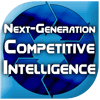 The Latest Visualisation Techniques Should Be Part of the CI Professional's Toolbox
The Latest Visualisation Techniques Should Be Part of the CI Professional's Toolbox
Jinfo Blog
30th May 2014
By Wayne Jones
Abstract
Competitive intelligence by its nature requires the presentation of new and complex ideas to audiences that are not necessarily predisposed to hear them. Wayne Jones explains how the latest visualisation tools and techniques can help your ideas get through to your audience.
Item
 Most competitive intelligence professionals know the basics of information visualisation – when to use a line chart versus a bar chart, how to highlight the clusters in a scatter plot.
Most competitive intelligence professionals know the basics of information visualisation – when to use a line chart versus a bar chart, how to highlight the clusters in a scatter plot.
Unfortunately, our colleagues (and internal competitors) all know these same tricks, so standing out from the crowd is more difficult than ever, as the overall quality of business presentations rises.
Stay Ahead of the Curve
To keep ahead of the curve, we can take three basic steps:
- Learn the latest features of our day-to-day software
- Explore new, cloud-based alternatives
- Participate in online communities that share visualisation best practices.
Fully Exploit Excel's Features
While almost everyone uses Microsoft Excel, few take advantage of its full capabilities or stay up to date on the latest releases. For those who haven't explored all of the menu options in even their aging editions, features such as conditional formatting can add clarity to complex datasets and draw attention to the most significant parts of a table.
For those using the current release, Excel 2013/Office 365 introduced a range of new visualisation features such as Quick Analysis and Recommended Chart, which examine the structure and ranges of your data to recommend the best from a set of common visualisations.
Explore Free Cloud-Based Apps
Most of the latest visualisation tools are deployed as cloud applications, and many have free versions that enable you to experiment before making a significant investment.
The most popular tool at the moment is Tableau, which is available in a free version known as Tableau Public. The tool offers a wide range of visualisations and interactive modes that can be shared online even with users that are not signed up for the software.
Tableau makes formerly complex data manipulation simple even for non-specialists, enabling users to explore a wide array of visualisations without too much concern for the structure of their data.
Take Tips from Peers
The best work of others engaged in data visualisation can inspire us to find improved ways to communicate insights about our own data.
Community projects such as IBM's Many Eyes provide open platforms for the sharing of datasets and visualisations, giving both new and experienced practitioners the opportunity to explore alternatives for presenting their own datasets. (Sorting by rating quickly surfaces the community's most impressive examples.)
Because members of the community can comment on and improve each other's contributions, you might find that someone has discovered a new and even more interesting way to look at your own data!
Focus on Keeping Stakeholders Engaged
Staying up to date on the tools and techniques of information visualisation ensures that our insights remain continually fresh and engaging to our stakeholders.
Ultimately, the goal of any market intelligence function is to drive beneficial change – keeping stakeholders engaged and finding the best ways to highlight the most valuable insights are important components of ensuring that your insights become actions.
Editor's Note
FreePint Subscribers can log in to read and share more in Wayne Jones' article, Turn Your Insights into Action with the Latest Tools for CI Communication.
This article is part of the FreePint Topic Series: Next-Generation Competitive Intelligence running from May-June 2014. Register your interest now, and you'll also get a free copy of the FreePint Report: Buyer's Guide on Competitive Intelligence when it's published in June.
- Blog post title: The Latest Visualisation Techniques Should Be Part of the CI Professional's Toolbox
- Link to this page
- View printable version
- Turn Your Insights into Action with the Latest Tools for CI Communication
Thursday, 29th May 2014 - Developing & Leveraging Your Primary Source Network for High Impact Competitive Intelligence
Thursday, 15th May 2014 - Collecting, Assessing and Organising Data for Competitive Intelligence
Wednesday, 7th May 2014 - Using Infographics to Promote Information Services
Wednesday, 10th July 2013 - Prezi: Set Your Presentations Free
Thursday, 13th June 2013
- The Importance of an Early Warning Primary CI Network
Tuesday, 27th May 2014 - Introducing the FreePint Topic Series: Next-Generation Competitive Intelligence
Thursday, 1st May 2014 - Widen Your Horizons: Research with Non-Text Sources
Tuesday, 25th June 2013
Register for our next Community session:

Team demand and AI
22nd January 2026
Latest on our YouTube channel:
Read on the Blog:
December 2025 update
3rd December 2025
- Team roles and AI (Community) 26th February 2026
- Team demand and AI (Community) 22nd January 2026
- Transforming knowledge management at BASF – GenAI and the evolution of QKnows (Community) 10th December 2025